Fire protection of air ducts is a mandatory component of design solutions used in the installation of modern ventilation systems. The use of materials with increased fire resistance significantly reduces the likelihood of combustion propagation in the event of a fire. Fire retardants are presented on the domestic market with special mastics, varnishes, and also special dyes. For fire protection of ventilation, fences made on the basis of basalt and other components are also used.
- Requirements for ventilation and smoke extraction systems
- Rules for the selection of materials for fire protection of air ducts
- Types and features of existing heat insulators
- Basalt based fire protection
- Thick-layer structures
- Combined and thin layer types of protection
- Fire protection installation procedure
- Typical errors
Requirements for ventilation and smoke extraction systems
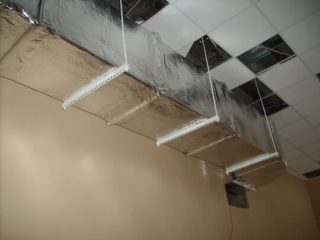
The list of fire safety requirements for fire protection of air ducts can be found in the rules of SP7.13130.2013. When arranging ventilation systems, the parameters of the flammability of fire retardants are taken into account, as well as their compliance with the category of the object: residential building, industrial premises, etc.
In addition, the following points are taken into account:
- the fire resistance limit of the material of the air ducts themselves;
- climatic factors (temperature, in particular);
- requirements for the serviced premises.
Fire protection of ventilation ducts and air ducts according to existing standards is equal to materials with fire resistance not less than the same indicator for wall panels.
When choosing equipment for high-rise buildings, it is allowed to use insulation and protective plates with flammability characteristics of class "A". It is allowed to use materials of category "B" (hardly flammable) in fire compartments. For air ducts that do not cross evacuation routes and structural elements of the roof, class B1 coatings are acceptable.
Rules for the selection of materials for fire protection of air ducts
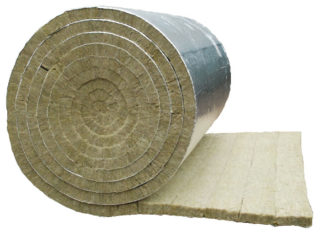
The fire-retardant coating of air ducts is selected taking into account its compliance with the fire safety levels established by the standards for modern structures and materials. In this case, the operating conditions of smoke removal systems (domestic or industrial) must be taken into account. To indicate the fire protection index of any material, the EI symbol is used, followed by a number corresponding to its fire resistance (within 15-150).
In accordance with SNiP, the following typical markings are adopted:
- EI 150 - materials intended for "walk-through" or transit air ducts;
- EI 45 - coverings and fences for vertical outlet structures;
- EI 30 - protection elements used within the fire block.
For thermal insulation of air ducts, it is recommended to select vibration-resistant materials with good soundproofing properties.
Types and features of existing heat insulators
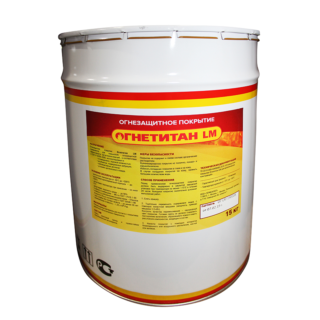
Fire protection of ventilation ducts included in forced ventilation systems is represented by the following special materials:
- fireproof insulation;
- fibrous structures based on basalt;
- thin-layer and thick-layer fences;
- elements of the combined type.
The first position is represented by mats of mineral wool or vermiculite, as well as basalt blocks of a suitable shape.To mount these materials on air ducts, separate fasteners such as self-tapping screws or steel wire are used.
Basalt based fire protection
Basalt fiber structures attract users with their resistance to vibrations and aggressive environments. In addition, they are completely safe for humans, lightweight, lack of shrinkage and low moisture permeability. These coatings are applied to the protected surfaces by spraying.
On the basis of the initial basalt structures, in addition to liquid coatings, mats and easy-to-install roll canvases are obtained. External protection elements increase the fire resistance of the surfaces of air ducts and ducts (E1). With an increase in the thickness of the applied layer, this indicator increases and under certain conditions can reach 150 units.
Thick-layer structures
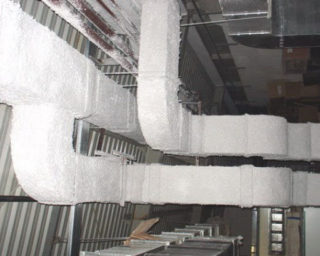
The elements of thick-layer fire protection include the following types:
- various types of plasters;
- special phosphate pastes;
- special mastics;
- asbestos and mineral fibers.
Liquid mixtures prepared on the basis of these materials are applied in a layer of up to 1 cm on a metal mesh previously fixed on the surfaces. At the same time, possible deformation and cracking of materials with sharp changes in temperature and humidity must be taken into account. In addition, when using massive thick-layer protection, the entire air-exhausting structure becomes somewhat heavier, which makes it necessary to use additional fasteners and spacers during its installation. When the gap between the wall and the duct is too small, it will be very difficult to do this.
Combined and thin layer types of protection
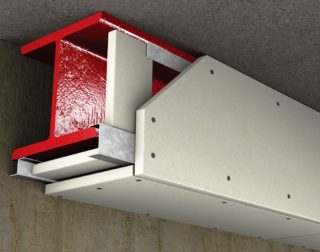
For the arrangement of fire insulation of combined type air ducts, mastics and roll compositions of various classes with a basalt base are used. In the process of protective treatment, the material is first applied to a previously prepared adhesive base, and then covered with a foil sheath. Thin-layer fire protection is a variety of dyes, as well as enamels and varnishes prepared on an organic (water) basis.
When the ambient temperature rises, a special carbonaceous layer is formed in the listed compositions, which has good thermal insulation characteristics. The benefits of liquid dyes include:
- durability;
- ease of application and low weight;
- aesthetics;
- profitability.
With the help of dyes, it is possible to process the most inaccessible places of ventilation structures. At the same time, coloring materials are inferior to other samples of protective coatings in terms of fire resistance. Another significant disadvantage of these products is their relatively high cost.
Fire protection installation procedure
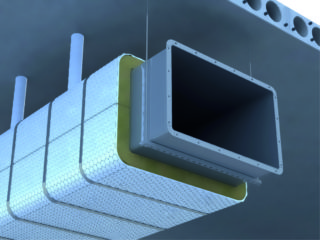
The procedure for arranging fire protection is determined by the type of material used (slabs, basalt wool or liquid mastic). Basalt fiber mats, for example, are attached to pipes with glue using special fasteners. In this case, the sequence of operations performed looks like this:
- The protected surfaces are thoroughly cleaned of traces of grease and dirt, degreased with a solvent.
- Move on to the preparation of the mountings. For this, pieces of soft steel wire are welded to the air duct body, by means of which the fire-resistant sheet is then attached.
- The protective material is cut into blanks, the size corresponding to the diameter of the pipes. To equip the base of the protective box (its lower plane), a whole sheet is taken. The sides and the lid are cut to the pipe diameter with a small margin for the design of joints (up to 10 cm).
- The surfaces of the slabs and the air outlet pipe are treated with an adhesive prepared in advance.
- Protective materials are applied with a layer of foil outside, and then fixed with standard hardware or wire.
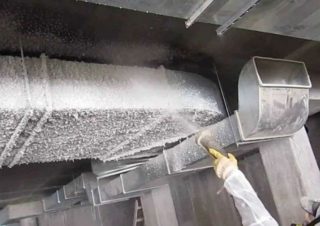
If the protective material has a liquid consistency, it is applied to the treated surfaces by spraying from a spray gun, or using special rolling rollers. In the simplest case, ordinary brushes are used for these purposes. At the end of the gluing and painting operations, the treated structure is allowed to settle until the protective composition is completely dry. Only after this is the full operation of the ventilation unit allowed.
In addition to the glue method of fastening, there are other methods, but mechanical options are most common. Among them, the use of special banding bands and fastening by means of welded pins or needles stand out. When using them, special attention is paid to the fire protection of air duct mounts, the quality of which determines the reliability of their operation.
Typical errors
When carrying out protective measures, it is important to consider the following points:
- It is not allowed to overlap in the areas where the strips of basalt can be joined.
- The same mistake should not be made when joining the fire retardant material with the elements of the enclosing structures.
- Brackets, hangers and other components of the air duct mounts must not be left without fire protection.
It is necessary to avoid mistakes, which are manifested in non-compliance of duct protection methods with the requirements of current standards.








